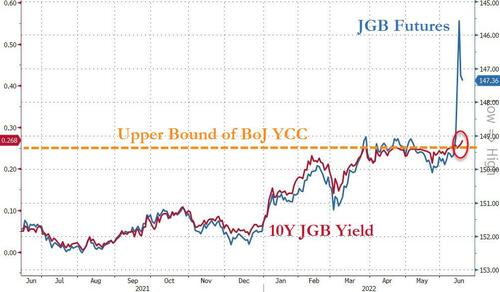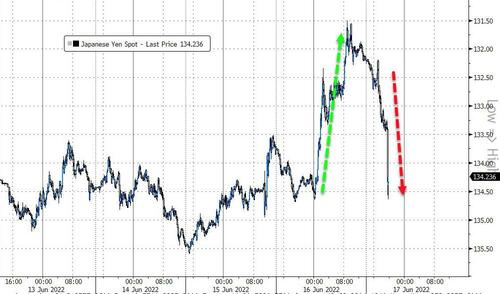
The yen weakened on Friday after the Bank of Japan maintained its ultra-easy monetary stance, increasing policy divergence with its global peers.
“While the decision was within expectations, those who want to challenge the BOJ will continue to do so, putting focus on Japan’s upper house election,” said Mari Iwashita, chief market economist at Daiwa Securities.
“I doubt if the challenge will pick up immediately after today’s decision, but the battle will resume in July.”
Governor Haruhiko Kuroda continued to signal a dovish stance, but the BOJ did make a rare reference to the currency market, saying it needed to watch its impact on the economy and markets.
“In this situation, it is necessary to pay due attention to developments in financial and foreign exchange markets and their impact on Japan’s economic activity and prices,” the central bank said in a statement, referring to risks from commodities, Covid-19, the war in Ukraine and overseas economic developments.
The 10Y JGB Yield is trading at around 27bps (2bps above the BoJ's YCC upper bound), while JGB futures are signaling the break is imminent still...
That is the highest 10Y yield since January 2016.
As Mari Iwashita, chief market economist at Daiwa Securities, notes:
“If the BOJ were to be pushed into a corner, it would come from the yen weakness progressing further or the proportion of BOJ holdings of 10-year bonds approaching 100%. Neither is taking place as of now.”
The immediate reaction is obvious - dumping of the yen as The BoJ is left to provide unlimited support/defense for the JGB market in th eface of unrelenting pressure sending yields higher...
The simple reality is - The BoJ has no way out of this... tick, tock!
The yen weakened on Friday after the Bank of Japan maintained its ultra-easy monetary stance, increasing policy divergence with its global peers.
“While the decision was within expectations, those who want to challenge the BOJ will continue to do so, putting focus on Japan’s upper house election,” said Mari Iwashita, chief market economist at Daiwa Securities.
“I doubt if the challenge will pick up immediately after today’s decision, but the battle will resume in July.”
Governor Haruhiko Kuroda continued to signal a dovish stance, but the BOJ did make a rare reference to the currency market, saying it needed to watch its impact on the economy and markets.
“In this situation, it is necessary to pay due attention to developments in financial and foreign exchange markets and their impact on Japan’s economic activity and prices,” the central bank said in a statement, referring to risks from commodities, Covid-19, the war in Ukraine and overseas economic developments.
The 10Y JGB Yield is trading at around 27bps (2bps above the BoJ’s YCC upper bound), while JGB futures are signaling the break is imminent still…
That is the highest 10Y yield since January 2016.
As Mari Iwashita, chief market economist at Daiwa Securities, notes:
“If the BOJ were to be pushed into a corner, it would come from the yen weakness progressing further or the proportion of BOJ holdings of 10-year bonds approaching 100%. Neither is taking place as of now.”
The immediate reaction is obvious – dumping of the yen as The BoJ is left to provide unlimited support/defense for the JGB market in th eface of unrelenting pressure sending yields higher…
The simple reality is – The BoJ has no way out of this… tick, tock!






